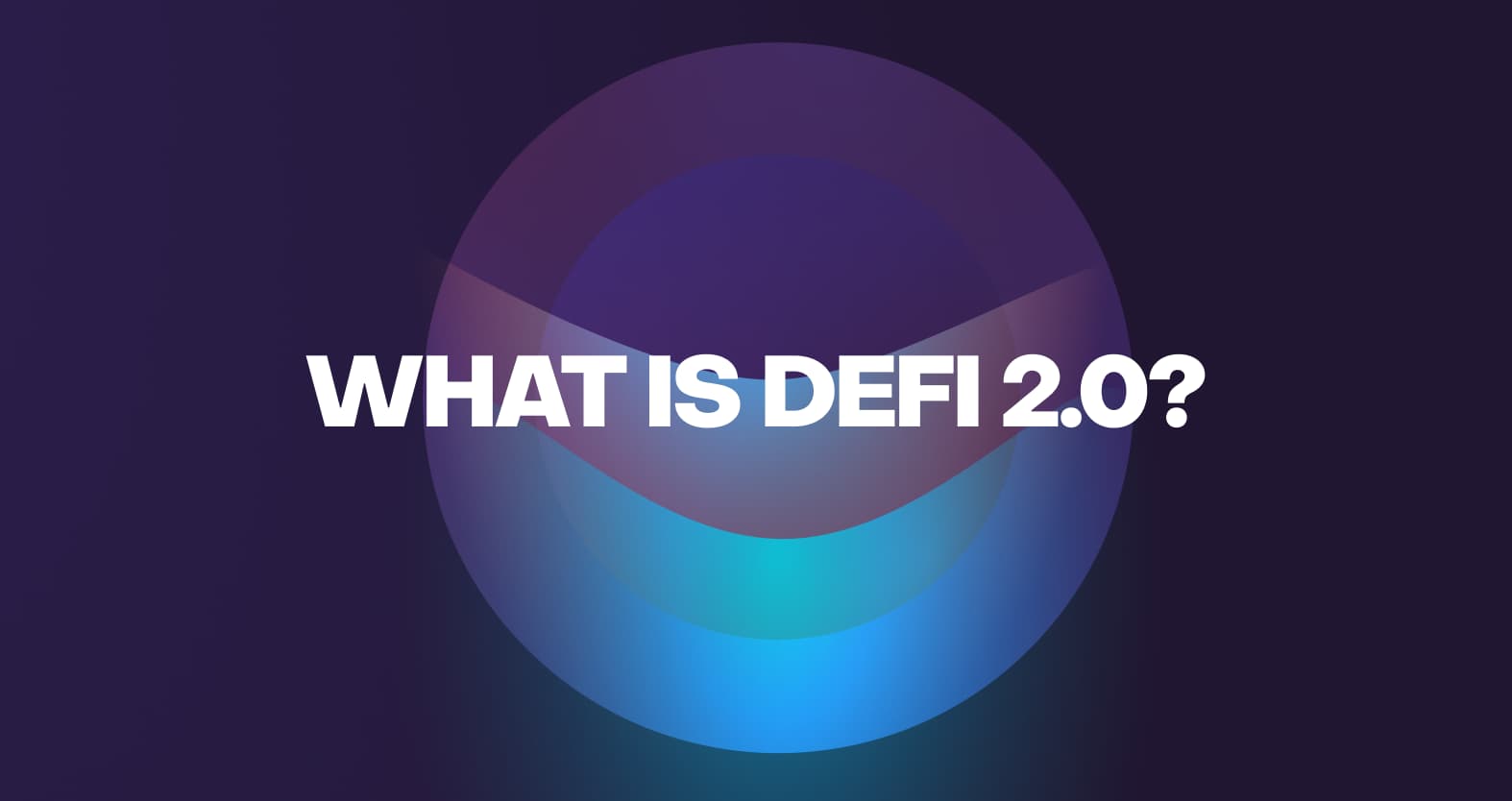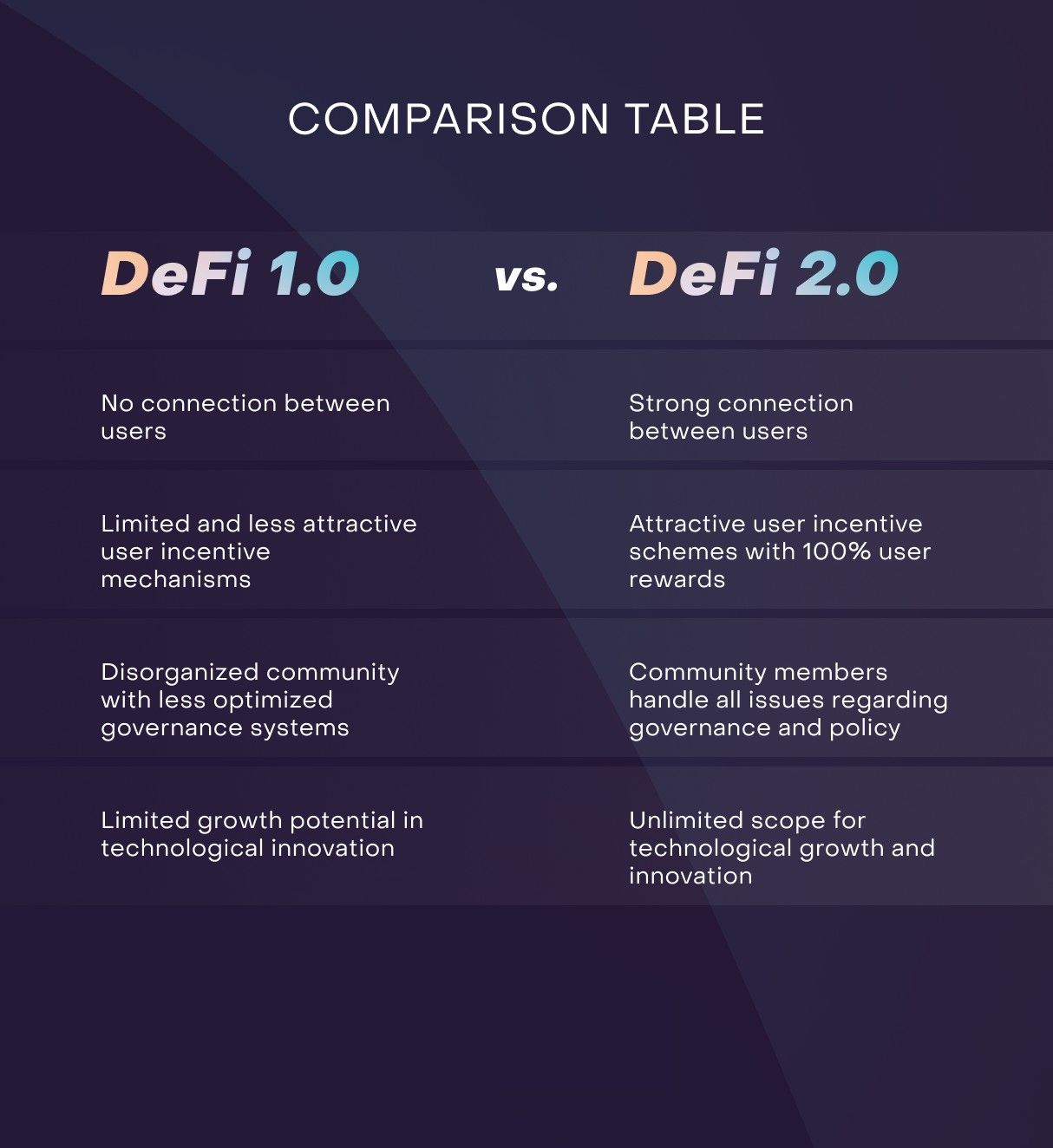
Table of contents
Decentralized finance (DeFi) has served as the supporting framework for many blockchain projects in recent years as developers continue to leverage its innumerable possibilities.
Although still in its infancy, DeFi has gained massive traction in the finance and tech space with more projects and protocols integrating related features. Regardless of its current usefulness, everything in the blockchain space continuously changes and improves. In 2022, an increase in liquidity-focused DeFi projects has ushered in a new decentralized finance phase known as DeFi 2.0.
What Is DeFi 2.0?
DeFi 2.0 is the second generation of decentralized finance protocols that address limitations affecting the first generation (DeFi 1.0). Some of these issues include scalability, security, liquidity, and accessibility of information. There is also the problem of usability. Several DeFi platforms require some niche knowledge, and are sometimes only usable by tech-savvy participants. DeFi 2.0 has now become necessary because decentralized finance projects offering innovative financial solutions are still grappling with these limitations.
Goals of DeFi 2.0
DeFi 1.0 ushered in decentralized liquidity pools (LPs), allowing liquidity providers to earn incentives for staking tokens in any given pool. However, LPs struggle with impermanent loss — a risk associated with rapid changes in token prices. These sudden swings eventually cause the liquidity providers to lose money.
DeFi 2.0 projects are already looking into insurance to combat this problem of impermanent loss. Insuring funds held in LPs will eliminate the worry about rapid changes and encourage more people to fund these pools.
Apart from impermanent loss, DeFi 2.0 aims to solve many other problems and improve the sector’s general usability and reliability. DeFi 2.0 also enhances user experiences and lowers the barriers to entry for the decentralized finance space.
Benefits of DeFi 2.0
DeFi 2.0 promises a plethora of benefits to the entire blockchain community. The following are some of these benefits:
- Improved capital efficiency by providing insurance for smart contracts to solve liquidation risks. Decentralized finance 2.0 offers protocol-controlled liquidity (PCL), where projects utilize users’ liquidity to invest in other blockchain projects and share the profit with the providers.
- Unlike DeFi 1.0, which relies heavily on US-backed stablecoins, decentralized finance 2.0 will not rely on fiat-backed stablecoins. DeFi 2.0 projects aim to create more sustainable replacements for stablecoins.
- Decentralized finance 2.0 will offer a better user experience at lower costs, directly supporting the mainstream adoption of DeFi.
- DeFi 2.0 ensures that smart contracts do not have exploitable inadequacies by establishing open-source communities and through utilizing insurance providers who conduct security audits.
- In DeFi 1.0, users that take out loans get exposed to high-interest rates on repayments. However, DeFi 2.0 helps mitigate this by offering self-repaying loans where a lender uses interests earned on deposited collateral to pay off the loan over time.
Growth of DeFi 2.0 Through Education and Integration
A primary DeFi 2.0 goal is to make decentralized finance easily accessible to the general public with a mainstream push in two directions, including education and integration with traditional financial systems.
- Education — DeFi 2.0 projects have simplified and user-friendly features that make it easy for users to navigate and learn. These projects also have materials that help users understand and use their respective platforms, as well as other features in the general DeFi space.
- Integration with Traditional Finance — The new DeFi iteration also promises to seamlessly integrate its features with centralized and traditional finance platforms through APIs and oracles that connect blockchains to external systems. Ultimately, the integration will allow users to leverage the benefits of DeFi protocols through traditional finance applications.
Limitations and Risks Of DeFi 2.0
Although DeFi 2.0 promises many benefits, the following risks may apply:
- DeFi 2.0 could expose users to risks of losing funds as smart contracts in this new phase may have loopholes or backdoors that hackers can exploit.
- Users still face the risk of impermanent loss. Even with liquidity insurance, users in DeFi 2.0 may still suffer impermanent loss. Improvements will considerably reduce this risk but does not eliminate it.
- Governments and regulators are taking an interest in the DeFi ecosystem. Hence, new laws and regulations born out of DeFi 2.0 growth could affect transactions or assets.
DeFi 1.0 vs. DeFi 2.0
Some of the key differences between DeFi 1.0 and DeFi 2.0 projects include:

How to Invest in DeFi 2.0
Anyone interested can participate in DeFi 2.0 using two major methods: buying tokens and using DeFi 2.0 platforms.
- Buying tokens is the easiest way to get involved in the DeFi 2.0 space. Users can trade or hold each protocol’s native token as preferred. As the project advances, the value of investments may also grow (if the assets are not stablecoins).
- Using DeFi 2.0 platforms opens users to a wide range of advantages. Users can generate returns and earn rewards from features such as yield farming, staking, crypto lending, liquidity provision, and mining.
DeFi 2.0 Projects
Some emerging projects are already developing protocols with DeFi 2.0 features, preparing the blockchain space for the second generation of decentralized finance. Examples include:
- Olympus DAO (OHM): Decentralized autonomous organization (DAO) which has a decentralized reserve currency model that offers bonds, liquidity pools, and staking.
- Abracadabra (MIM): DeFi lending platform that lets users deposit interest-bearing tokens from other protocols.
- Convex Finance (CVX): Yield farming platform with one of DeFi’s most considerable TVL (total value locked) amounts.
- Yearn Finance ($YFI): DeFi yield and lending aggregator service that provides insurance on the Ethereum blockchain.
As the general fintech space continues to progress, the second phase of decentralized finance promises to combat the limitations and risks associated with DeFi 1.0. The expected improvement will significantly enhance the global acceptance of DeFi and expand the blockchain ecosystem.
Experience DeFi 2.0 with AtomicDEX
AtomicDEX is your gateway to DeFi 2.0. Store and trade your favorite cryptocurrencies in one app.
AtomicDEX supports dozens of blockchain protocols and their assets. A few examples include BTC, ETH, BNB, and YFI.




